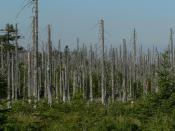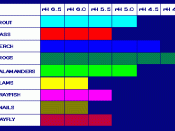Acid rain is a form of air and pollution resulting from toxic emissions (poisonous gases and particles released into the air) by industry, transportation, and home heating. At the moment acid rain is threatening lakes of the United States, Canada, and Europe, and also posing a threat to their forests, farmlands, soils and buildings.
Acid rain is one of the most significant environmental threats to face the people of the world today. How we deal with this problem will have a major impact on future generations.
People have created the acid rain problem. Factories, transportation systems, and electrical and heating plants all release tremendous quantities of toxic particles and gases such as sulfur dioxide (SO) and nitrogen oxides into our atmosphere. Most of the particles float in the air for a while and later fall back to Earth. Others rise higher in the air and combine with moisture in the clouds to from sulfuric acid (HSO) and nitric acid (HNO).
As the clouds become laden with this toxic moisture, they release their liquid burden, which falls back to Earth in the form of rain, snow, sleet, hail or fog. Carried by the wind, these toxic substances can travel great distances affecting areas far from the source. This liquid fallout is what is known as acid rain.
Fish are the organisms that are affected the most by acid rain. As low acid rain levels fall into lakes most fish live. However they just get ill or have trouble growing. But when the acid levels get high enough, all the fish die out.
As acid rain continues to fall, leached metals (metals that have had nutrient salts washed away from them), salts and acids flow into rivers and lakes, changing the chemical make up of the water. Aluminium, one of...


